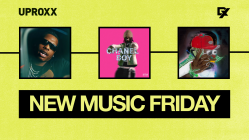In 2002, the world ended its patient wait for Rapheal Saadiq‘s solo debut Instant Vintage, an album that incorporated old and new stylings in a homogenous blend intended to save the then-declining R&B. Received warmly, the album approached expectations, but failed to leave the lasting impression intended. Six years later, Saadiq, who’s become more of a producer than artist in the public eye, drops The Way I See It on the musically-daring, Rick Rubin era of Columbia Records. What Anthony Hamilton‘s best work has been to ’70s Soul, this is to ’60s R&B. The 42 year-old frontman of Tony! Toni! Tone! made an album that sounds like Berry Gordon simply forgot to release it in 1965, with some pleasant musings included for those ’80s babies.
“Oh Girl” is this album in a microcosm. With a delivery reminiscent, and overtly influenced by The Stylistics and Gladys Knight & The Pips, subtle strings guide the light-voiced singer to a more contained range than ever offered previously. Sixties Motown percussion icon Jack Ashford and Paul Riser deserve much credit for giving true authenticity to Saadiq‘s sound, as heard on “Keep Marchin’,” deeply evocative of the backing sounds to early Temptations and Miracles singles. Just as Martha Reeves‘ “Dancing In The Streets” or “Nowhere To Run,” even the most seemingly love ballad can take on political meaning, in Saadiq‘s clever and socially aware Oakland, California songwriting. Regardless of whether the underlying issues address race, class or otherwise, a listener cannot help but feel good amidst The Way I See It‘s journey. Always cheerful on records, Saadiq seems to have reached a personal state of euphoria. As he sings about his wife on “Kiss From You,” assisted by Saadiq‘s superstar protégé Joss Stone, it’s clear that this album conquers the level of togetherness and understanding that today’s R&B star, save for Jaheim, typically shuns. Although Saadiq does what ’60s singers could not do, in his broad strokes about lust and sex, there is no cheap thrill on this album – the messages are deeper, and more timeless than making love in a club or putting a loved one to “bed.”
Self produced, with notable help from longtime drummer Bobby Ozuna, The Way I See It employs dozens, literally, of studio musicians on each song. Almost entirely recorded in a historic Los Angeles studio, it’s almost peculiar to see Saadiq use technology to record horn sections outside of his sessions. The finished product keeps this secret well, as the album’s crisp mastering still pay homage to vintage levels, as The Funk Brothers’ formula and success lives on. Stevie Wonder naturally touches an album that channels his earliest work, appearing on the “Never Give You Up.” Rather than sound like the epic collaboration in marks, Saadiq, Wonder and CJ Hilton form a makeshift group for the song, singing more as a unit than three separate entities. The one album anachronism comes as Jay-Z [click to read] hops on the remix to “Oh Girl” [click to listen] Coming late in the album, and delivered with a newlywed’s level of sincerity, Hov is welcomed to the party, although his beginning bars, delivered in sing-talking, catch even the most seasoned ear off-guard.
Arguably, R&B has been on a bigger detour than Hip Hop the last decade. Few singers can show you their eyes, let alone their hearts, as the Jodeci formula of taking rap themes to song has fully occupied a genre that rarely encourages writing or self-production. Just as he was there to challenge the genre in 1990, Rapheal Saadiq snatches it back in ’08. Like Erykah Badu‘s own renaissance [click to read], this is feel-good music in the mainstream with the biggest cosigns possible. Fitted suits, Chesterfields and true love replace iPhones, D&G shades and Magnum‘s as R&B makes a much-needed pilgrimage back in time.





![50 Cent Shares Unseen Diddy Footage From Netflix Documentary: "[It] Shows You His Character"](https://hiphopdx.com/wp-content/uploads/2025/12/50-cent-diddy-documentary-trailer-unseen-footage.jpg?w=250)



